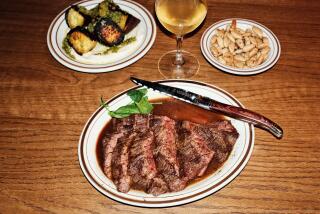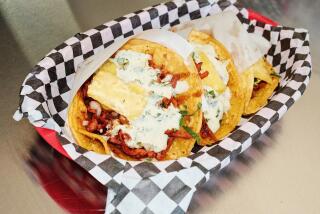Curd is the Word
- Share via
GARDEN GROVE — The Shinto minister stood before the shrine, where several oversized sake bottles perched high on a stand. As a harpist softly played, he offered mulberry branches and white rice paper as symbols of purity, gratefulness and sanctity.
He bowed and clapped rhythmically, and prayed for good fortune to “the principal parent of this grand and glorious universe.”
And so the nation’s largest tofu factory was officially opened in Garden Grove on Wednesday.
Demand for the bean curd--a staple in Asia--is increasing in the United States due to Americans’ fixation on healthy foods and a growing Asian population. Domestic retail sales climbed from $40 million in 1979 to more than $130 million in 1995, according to the Soyfoods Assn.
Best known in its native country as a maker of snack foods and curry powder, Osaka-based House Foods owns and operates the new $21-million, 130,000-square-foot plant. The concern is betting that its U.S. tofu sales, until now about $10 million a year, will take off.
The new factory, which replaces House Foods’ old plant in Los Angeles’ Little Tokyo district, will more than double its tofu production to 150,000 pounds a day.
“House is an old, established company in Japan,” said Harry Tanikawa, the sales manager of its U.S. subsidiary, House Foods America Corp.
“We’d like to educate the American consumer. We’ve never totally taken the opportunity to do that, and now we can.”
But at its carefully orchestrated opening ceremony, House Foods also might have prayed that its U.S. expansion will help it withstand growing pressures at home.
With about $1.7 billion in annual sales, it has historically had among the highest profit margins in the Japanese food industry, said Patricia Horvath, an analyst at UBS Ltd. in Tokyo.
But House Foods’ profits have sagged the past couple of years because of increased competition, the Japanese recession, and a weaker yen that has made importing raw materials more expensive. So Horvath said the company might be looking abroad for new sources of growth.
The big push in the tofu market in the United States is a bit puzzling, since the company doesn’t make tofu in Japan, she said.
Still, Horvath finds House Foods’ aggressiveness in the United States encouraging. In the past, she said, the company has sat back while other Japanese firms have won over American consumers with their packaged noodles.
House Foods also owns a dairy distributor in Hawaii and the five-restaurant Curry House chain in Southern California. It bought an interest in the Hinoichi tofu plant in Little Tokyo in 1983. But it didn’t buy the tofu business outright for another decade, at which time the plant had been operating at full capacity for years.
At the same time, its main rival, South San Francisco-based Vitasoy, was growing quickly by acquiring smaller companies.
So observers say that House Foods’ new factory, which will have 150 workers by the time it’s fully operational next month, comes none too soon.
*
A staple of Asian diets for more than 1,000 years, tofu is sometimes called “meat of the fields” or “meat without a bone.”
In this country, tofu has been championed by vegetarians as a meat substitute because it’s high in protein but low in fat and cholesterol. They’ve fought to overcome the typical American impression of tofu as soggy and tasteless by promoting its chameleon-like qualities, which allow it to be molded into a variety of forms and take on the taste of anything it is mixed with.
Ironically, while there are some large tofu plants in Japan, tofu-making there remains dominated by the more than 25,000 shops where “tofu masters” adhere to age-old traditions.
In “The Book of Tofu,” authors William Shurtleff and Akiko Aoyagi describe the work of a tofu master: “His movements were precise and graceful, joined in an effortless rhythm that, at times, flowed like a dance. A true master, he held in highest esteem the traditional, natural way and the spirit of fine craftsmanship.”
Though the House Foods plant is fully automated with what company officials say is state-of-the-art equipment, the basic process for making tofu remains the same.
The soybeans are cleaned, then soaked in water for half a day to soften and expand them and remove their hulls. The beans are ground, cooked and squeezed to extract the “milk.” The bean fiber is discarded for cattle feed, while the soy milk is mixed with a coagulant, calcium sulfate.
The pudding-like mixture is dropped into boxes, cut and placed in packages with water, then pasteurized. From a refrigerated warehouse, the packages are shipped to distributors, supermarkets and specialty grocers.
The new plant even has a test kitchen, where a resident home economist will test recipes and consult with dietitians in hopes of encouraging greater American acceptance of tofu.
*
The Shinto ceremony, as traditional to the Japanese when opening a new business as the christening of ships is to Westerners, was meant to give the factory a proper send-off.
The Rev. Alfred Y. Tsuyuki of the Konko Church of Los Angeles, who officiated, said he has blessed buildings all over the country. “These plants have made millions off of me,” he quipped.
But House Foods was apparently leaving nothing to chance. Before guests were ushered away to a lunch of traditional Japanese fare and tofu lasagna, company officials engaged in a typically American gesture.
They cut a ribbon.
(BEGIN TEXT OF INFOBOX / INFOGRAPHIC)
What Is Tofu?
Tofu, a soft, cheese-like food made from soybeans, water and a calcium-based coagulant, is finding increasing favor in the U.S. A tofu primer:
Origins: Developed in China around 178 to 200 BC; its use spread to East Asian countries including Korea, Malaysia, Vietnam, Thailand and Japan
Benefits of soy: Good source of vegetable protein, unsaturated fats, vitamin E and saponins, a substance said to reduce cholesterol levels; soy milk is often used to nourish infants and those unable to digest cow’s milk
Shelf life: 20 to 40 days refrigerated
Other soy products: Liquid and powdered infant formula, fruit-flavored beverages, meat substitutes such as soy bacon and hamburger
How is tofu made?:
1. Soybeans are washed and soaked in water for 10 to 13 hours until soft and swollen
2. More water is added and beans are ground
3. Soybeans are then cooked and the liquid portion, known as soy milk, is separated
4. Calcium is added to thicken the soy milk into a soft curd
5. Excess liquid removed, depending on the desired firmness; curd compressed into blocks
6. Blocks packaged into tubs filled with clean water
7. Tubs are sealed and pasteurized
8. Placed in cold storage and shipped
Degrees of Firmness
How the various tofu consistencies are used:
Silken: Pureed dishes such as dips, spreads, dressings, desserts and shakes
Soft: Sauces, soups and salads
Firm: Sliced, diced, pan fried and used as a filling or stuffing; can be scrambled like eggs or seasoned and used as a filler or meat substitute in meatloaf, tacos and other dishes
Extra-firm: Eaten fried, like a cutlet; chopped up into stir-fry dishes or deep fried into small puffs
Sources: Vita Soy, House Foods America Corp.
More to Read
Inside the business of entertainment
The Wide Shot brings you news, analysis and insights on everything from streaming wars to production — and what it all means for the future.
You may occasionally receive promotional content from the Los Angeles Times.











